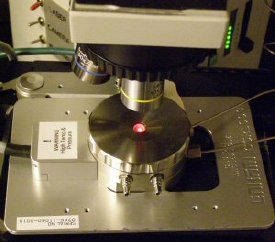The new catalyst stage from Linkam has been designed to study catalytic reactions at high temperature and pressure. Samples are mounted on a virtually non-reactive disposable ceramic fabric filter enabling the carrier gas to pass through the sample inside the ceramic heating element which is capable of heating samples from ambient up to 1000°C and at pressures of up to 5 bar.
 Linkam’s new Catalyst CCR1000 system in use at the R&D facility of Haldor Topsǿe in Denmark.
Linkam’s new Catalyst CCR1000 system in use at the R&D facility of Haldor Topsǿe in Denmark.
Success stories for new technology are always good to report and the R&D division of world-leading catalyst and technology company, Haldor Topsǿe, have chosen the Linkam system after years of trying other in situ characterization approaches, (e.g. TEM, XAS, XRD or Raman spectroscopy) to identify under reaction conditions which specific sites in their catalysts are responsible for the catalytic activity.
For example, oxidation of SO2 into SO3 over vanadium based supported liquid phase catalysts, is the key stage in the industrial production of sulphuric acid. SO2 oxidation catalysts are also used to efficiently remove SO2 emissions from carbon fired power plants and thereby contribute to the reduction of acid rain and urban smog. In one series of experiments, a commercial sulphuric acid catalyst (VK-38) has been investigated recently by means of in situ Raman spectroscopy using Linkam’s high temperature catalytic cell reactor. In situ Raman spectra were recorded in a sulphur dioxide containing atmosphere (2000 ppm SO2 in air) in the temperature range from 300 to 400 °C, while conversion was measured with an infrared SO2 analyser. It was observed that at around 300 – 350 °C, the catalyst starts to take up SO2 from the gas phase, forming a molten alkali pyrosulphate, which dissolves the vanadium salts and thereby forming the active supported molten phase. Significant conversion of SO2 starts at around 350 °C and is progressively increased when the temperature is raised up to 400 °C (at 400 °C the conversion was 65%). The proposed active dimeric vanadium sulphate species in the melt can be detected by the presence of the Raman band at 1050 and 1176 cm-1 Combining an advanced hot stage designed specifically to work in very aggressive conditions with Raman spectroscopy has revealed significant new data in a very convenient to use bench-top system.
Commenting on the work at Haldor Topsǿe, Linkam Director, Vince Kamp, said that this is an excellent example of how our users have adapted the experimental set-up to study their materials in a real-world environment. Linkam, with the well-proven philosophy of listening to customer needs in the design of new products, see the catalyst system as a valuable addition in materials characterisation to meet the multi-disciplinary requirements of the modern analysis and R&D laboratories.